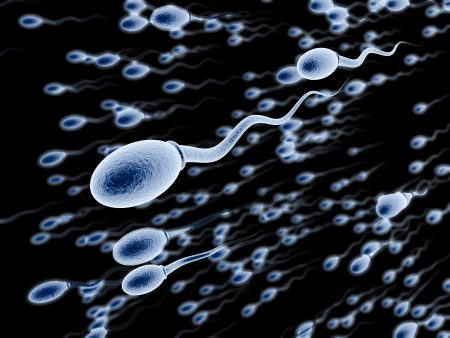Phthalates in Plastics and Creams Cause Epigenetic Changes to Sperm
A recent study suggests that chemicals called phthalates that are used to make plastic flexible and to improve the texture of lotions, creams, and powders have effects on human sperm. Phthalates have become common in our environment since the invention of plastics, and most people have detectable levels of phthalate metabolites in their bodies.
The study, published by Haotian Wu and colleagues in the journal Human Reproduction in 2017, measured DNA methylation in a group of men’s sperm and compared this to levels of phthalate metabolites in the men’s urine.
DNA methylation changes the structure of a DNA strand. Extra methyl groups are attached to the strand, affecting the way it is transcribed, even though the inherited genetic sequence on the DNA strand remains the same. Changes like these to the structure of DNA and histones, which give DNA its helix shape, are known as epigenetic changes.
Wu and colleagues found 131 regions of DNA methylation in the men’s sperm that they could link to at least one of the phthalate metabolites found in the men’s urine.
Sperm takes 72 days to mature. Wu and colleagues suggest that exposure to phthalates in plastics or personal care products during this period may cause alterations to sperm, which could potentially affect the ease of conception or the development of potential offspring. The changes the researchers observed affected genes related to growth, development, and cellular function and maintenance.
In addition to chemical exposure, stressors and drug use can also bring about epigenetic changes to sperm. A father’s offspring may then have altered risk of drug use or other behaviors as a result of these epigenetic changes.
Phthalates, which can disrupt the endocrine system, have previously been found to alter men’s hormone levels and to hurt sperm quality. This is the first study to find that in people, phthalate concentrations measured before conception are associated with DNA methylation in sperm. This was a fairly small study in 48 men, and it remains to be studied whether the changes to sperm affect the offspring’s prenatal and early childhood development.
In addition to their presence in flexible plastics, phthalates may also be found in products such as shaving cream, shampoo, soaps, and detergents.
In Rats, Dad’s Cocaine Use Affects Son’s Spatial Memory
Evidence is mounting that certain behaviors by parents can leave marks on their sperm or eggs that are passed on to their offspring in a process called epigenetics. In a recent study by researcher Mathieu Wimmer and colleagues, male rats that were exposed to cocaine for 60 days (the time it takes for sperm to develop fully) had male offspring who showed diminished short- and long-term spatial memory compared to the offspring of male rats that were not exposed to cocaine. Female offspring were not affected in this way.
The spatial tasks the offspring rats completed depended heavily on the hippocampus. Wimmer and colleagues believe that cocaine use in the fathers decreased the amount of a brain chemical called d-serine in the offspring. D-serine plays a role in memory formation and the brain’s ability to form synaptic connections. Injecting the offspring of rats who were exposed to cocaine with d-serine before the spatial memory tasks normalized the rats’ performance.
Transgenerational Transmission of Drug Exposure and Stress in Rodents
New data suggest that there can be transgenerational transmission of the effects of drug exposure and stress from a paternal rat to its offspring. The father mates with a female who was not exposed to drugs or stress and never has any contact with the offspring. Consensus is now building that this transmission occurs via epigenetic alterations in sperm.
Epigenetic alterations are those that are mediated by chemical changes in the structure of DNA and of the histones around which DNA is wrapped. These changes do not alter the inherited gene sequences but only alter how easy it is for genes encoded in the DNA to be activated (transcribed) or suppressed (inhibited).
There are three common types of epigenetic modifications. One involves the attachment of a methyl or acetyl group to the N-terminals of histones. Methylation typically inhibits transcription while acetylation activates transcription. Histones can also be altered by the addition of other compounds. The second major type of epigenetic change is when the DNA itself is methylated. This usually results in inhibition of the transcription of genes in that area. The third epigenetic mechanism is when microRNA (miRNA) binds to active RNA and changes the degree to which proteins are synthesized.
At a recent scientific meeting, researchers described the various ways epigenetic changes can be passed on to future generations.
Researcher Chris Pierce reported that chronic cocaine administration increased brain-derived neurotrophic factor (BDNF) in the medial prefrontal cortex of rats. (BDNF is important for learning and memory.) The cocaine administration led to acetylation of the promoter for BDNF.
This exposure to cocaine in male rats who then fathered offspring led to two changes in the offspring, presumably conveyed by epigenetic changes to the fathers’ sperm. The first change was a decrease in cocaine reinforcement. The offspring took longer to acquire a cocaine self-administration habit. The second change was long-lasting learning deficits in the male offspring, specifically recognition of novel objects. The deficit was associated with a reduction in long-term potentiation in the offspring. Long-term potentiation is the strengthening of synapses that occurs through repeated patterns of activity. Surprisingly, the following generation also showed deficits in learning and memory, but did not show a loss of long-term potentiation.
Editor’s Note: These data indicate that alterations in sensitivity to cocaine (in this case slower acquisition of cocaine self-administration) can be transferred to a later generation, as can learning deficits in males. These data suggest that fathers’ experience of drugs can influence cocaine responsiveness and learning via epigenetic mechanisms likely mediated via epigenetic changes to the father’s sperm.
This research suggests the possibility that, in a human clinical situation, there would be three ways that a father’s drug abuse could affect his child’s DNA. First, there is the traditional genetic inheritance, where, for example, an increased risk for drug abuse is passed on to the child via the father’s genetic code. Next, drug abuse brings about epigenetic changes to the father’s sperm. (His genetic code remains the same, but acetyl groups attach to the BDNF promoter section of his DNA, changing how those proteins get produced.) Lastly, if the father’s drug abuse added stress to the family environment, this stress could have epigenetic effects on the child’s DNA.
Researcher Alison Rodgers described how epigenetic changes involving miRNA in paternal rats influence endocrine responsivity to stress in their offspring. Rodgers put rats under stress and observed a decrease in hormonal corticosterone response to stress. When a father rat was stressed, nine different miRNAs were altered in its sperm. To prove that this stress response could be passed on transgenerationally via miRNAs, the researchers took sperm from an unstressed father, loaded it with one or all nine miRNAs from the stressed animal, and artificially inseminated female rats. Rodgers found that the sperm containing all nine miRNAs, but not the sperm carrying one randomly selected miRNA, resulted in offspring with a blunted corticosterone response to stress.
Researcher Eric Nestler showed that when a rodent goes through 10 days of defeat stress (being defeated repeatedly by a larger animal), they begin to exhibit behaviors resembling those seen in depression. Social avoidance was the most robust change, and continued for the rest of the animal’s life. Animals did not have to be physically attacked by the bigger animal to show the depression-like effects of defeat stress. Just witnessing the repeated defeats of another rat was sufficient to produce the syndrome. Again, father rats that experienced defeat stress or witnessed it passed this susceptibility to defeat stress on to their offspring (with whom they never had any contact), likely by epigenetic changes to sperm. Read more




